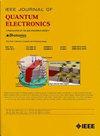Vertical Coupling Effect on Gain Bandwidth of Chirped InAs/InP Quantum Dot Structures
IF 2.1
3区 工程技术
Q3 ENGINEERING, ELECTRICAL & ELECTRONIC
引用次数: 0
Abstract
Quantum dot (QD) devices are usually desired to have a broadband gain spectrum. An alternative solution to achieve a broadband gain in QD devices is to use multiple layers with different QD heights, which are stacked vertically, i.e. a chirped QD structure in the active region. In the chirped stacked QD structure, the vertical strain and electron coupling effect have a significant impact on the optical transition property and thus optical gain bandwidth. However, previous studies on the vertical coupling effect have mainly focused on uniformly stacked QD structures, and the chirped QD structures have not been investigated carefully. This work presents a detailed analysis of the vertical coupling effect in chirped QD structures (i.e. ascending and descending chirped structure) and its impact on the optical gain bandwidth of the active region. It is found that the descending chirped structure leads to a wider gain bandwidth, in particular at high current injection. A Fabry-Perot mode-locked laser with the descending chirped structure presents a better performance in pulse width and frequency comb lines compared to the ascending chirped structure.垂直耦合对啁啾 InAs/InP 量子点结构增益带宽的影响
量子点(QD)器件通常需要具有宽带增益频谱。在量子点器件中实现宽带增益的另一种解决方案是使用多层不同高度的量子点垂直堆叠,即在有源区采用啁啾量子点结构。在啁啾堆叠的 QD 结构中,垂直应变和电子耦合效应对光学转变特性和光学增益带宽有重要影响。然而,以往对垂直耦合效应的研究主要集中在均匀堆叠的 QD 结构上,对啁啾 QD 结构的研究并不深入。本研究详细分析了啁啾 QD 结构(即升啁啾和降啁啾结构)中的垂直耦合效应及其对有源区光增益带宽的影响。研究发现,下降啁啾结构能带来更宽的增益带宽,尤其是在高电流注入时。与上升啁啾结构相比,采用下降啁啾结构的法布里-珀罗锁模激光器在脉冲宽度和频率梳状线方面具有更好的性能。
本文章由计算机程序翻译,如有差异,请以英文原文为准。
求助全文
约1分钟内获得全文
求助全文
来源期刊

IEEE Journal of Quantum Electronics
工程技术-工程:电子与电气
CiteScore
4.70
自引率
4.00%
发文量
99
审稿时长
3.0 months
期刊介绍:
The IEEE Journal of Quantum Electronics is dedicated to the publication of manuscripts reporting novel experimental or theoretical results in the broad field of the science and technology of quantum electronics. The Journal comprises original contributions, both regular papers and letters, describing significant advances in the understanding of quantum electronics phenomena or the demonstration of new devices, systems, or applications. Manuscripts reporting new developments in systems and applications must emphasize quantum electronics principles or devices. The scope of JQE encompasses the generation, propagation, detection, and application of coherent electromagnetic radiation having wavelengths below one millimeter (i.e., in the submillimeter, infrared, visible, ultraviolet, etc., regions). Whether the focus of a manuscript is a quantum-electronic device or phenomenon, the critical factor in the editorial review of a manuscript is the potential impact of the results presented on continuing research in the field or on advancing the technological base of quantum electronics.
 求助内容:
求助内容: 应助结果提醒方式:
应助结果提醒方式:


